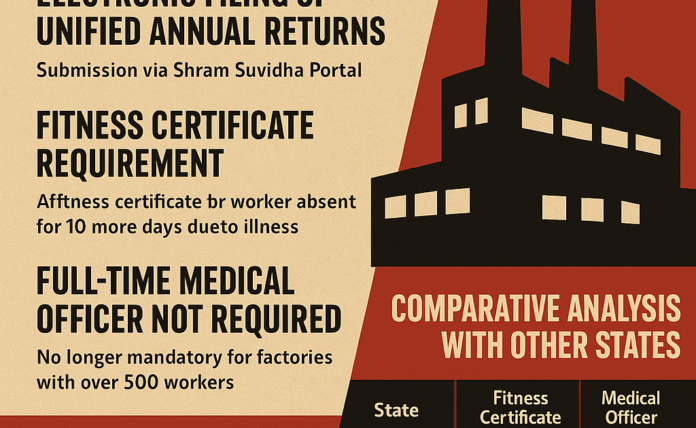📅 Date of Notification: 20th June 2025
📌 Issued by: Labour, Skill Development, and Employment Department, Gujarat
📜 Legal Reference: In exercise of powers under Section 112 of the Factories Act, 1948
🔍 Key Highlights of the Gujarat Factories (Amendment) Rules, 2025
1. Digitalization of Returns (Rule 119 Amendment)
- Old Rule: Manual submission of returns was permitted.
- Amendment: Employers must now submit Unified Annual Returns electronically via the Shram Suvidha Portal.
- Legal Authority: Section 112 read with Rule 119 of the Gujarat Factory Rules.
🖥️ Impact:
- Boosts compliance efficiency and transparency.
- Reduces paperwork, enhances tracking by inspectors.
- May challenge smaller units unfamiliar with digital platforms.
2. Medical Fitness Clarification for Workers (Rule 125 Amendment)
💡 Why this matters:
- Enhances occupational health and safety.
- Reduces risk of communicable diseases in dense factory environments.
3. Simplification of Medical Officer Employment Rules (Rule 18-A Omission)
- Old Requirement: Every factory employing more than 500 workers needed a full-time medical officer.
- 2025 Amendment: Rule 18-A omitted—no longer mandatory to appoint a full-time Medical Officer based on worker count.
⚖️ Implications:
- Cost-saving for factories, especially in non-hazardous sectors.
- Raises concerns for worker welfare and medical readiness in emergencies.
⚖️ Comparative Analysis with Other State Factory Rules
| State | E-Return Filing | Fitness Certificate Rule | Medical Officer Requirement |
|---|---|---|---|
| Gujarat (2025) | Mandatory via Shram Suvidha | Mandatory after 10 days leave | Removed |
| Maharashtra | Mandatory (since 2021) | Recommended, not enforced | Required for >500 workers |
| Tamil Nadu | Mandatory via online portal | Required after prolonged illness | Required for hazardous industries |
| Karnataka | Mandatory | No clear directive | Based on factory size & sector |
| Delhi | Voluntary; moving to mandatory | No clear mandate | Required for >500 or hazardous |
| Haryana | Mandatory | Silent on this aspect | Required under certain schedules |
📊 Conclusion: Gujarat aligns with the national digitalization trend but departs in relaxing medical infrastructure requirements—a move seen as pro-industry but with debatable worker health consequences.
✅ Legal & Industrial Impact
👷 For Employers
-
Pros:
- Compliance simplification through unified e-returns.
- Flexibility in staffing medical personnel.
- Cons:
- Increased digital responsibility.
- Monitoring of worker health becomes the employer’s liability.
🧑🏭 For Workers
📝 Final Thoughts
The Gujarat amendment is a hybrid step—progressive in terms of administrative ease, yet controversial due to relaxation in medical staffing norms. Other states are likely to observe its implementation impact before considering similar changes.
It marks a shift toward “Ease of Doing Business” in manufacturing, while balancing worker welfare needs. Stakeholders—including worker unions, industry bodies, and legal experts—must monitor its on-ground effects closely.
🔗 Suggested Read:
Notification
#GujaratFactories2025 #LabourLawUpdate #FactoriesAct1948 #DigitalCompliance #WorkerSafety #EaseOfDoingBusiness #IndustrialSafetyIndia #GujaratNews2025 #LabourReformsIndia #EmploymentLawUpdate
Gujarat Factory Rules 2025, Gujarat Labour Law Amendments, Factories Act Amendments India, Labour Law Update 2025, Factory Compliance India, Factory Medical Officer Rule, Factory e-returns India, Gujarat Industrial Laws, Occupational Health & Safety India, Shram Suvidha Portal Compliance


%20Rules,%202025.png)




